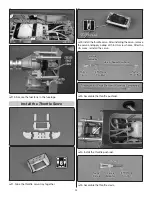
28
Balance the Model Laterally
ELECTRIC ONLY:
Install the fl ight batteries, but
do not plug
the batteries into the ESC.
❏
1. Install the wing and wing bolt plate. With the wing
level, have an assistant help you lift the model by the engine
propeller shaft and the bottom of the fuse under the TE of
the fi n. Do this several times.
❏
2. If one wing always drops when you lift the model,
it means that side is heavy. Balance the airplane by
adding weight to the other wing tip.
An airplane that
has been laterally balanced will track better in loops
and other maneuvers.
Balance the Model (C.G.)
DO NOT OVERLOOK THIS IMPORTANT PROCEDURE.
A
model that is not properly balanced may be unstable and
possibly unfl yable.
6-7/16"
8-1/8"
[161mm]
[203mm]
❏
1. Mark the C.G. location.
❏
2. With the plane
ready to fl y
, with an empty fuel tank or
motor batteries installed, use a Great Planes C.G. Machine
placed on a couple of supports to raise it or apply narrow
(1/16" [2mm]) strips of tape at the front and rear C.G. locations
so you will be able to feel them when lifting the model with
your fi ngers to check the C.G. location.
Do not at any time
balance the model outside this C.G. range
.
❏
3. Use Great Planes segmented weights (GPMQ4485) to
balance the plane. Place incrementally increasing amounts
of weight on the bottom of the fuselage over the location
where it would be mounted inside until the model balances.
A good place to add nose weight is to the fi rewall. Once you
have determined if additional weight needs to be installed,
permanently attach the weight with glue or screws.
❏
4.
IMPORTANT:
If you found it necessary to add any
weight, recheck the C.G. after the weight has been installed.
PREFLIGHT
Identify Your Model
You should always have your name, address, telephone
number and AMA number on or inside your model. It is
required
at all AMA R/C club fl ying sites and AMA sanctioned
fl ying events. Fill out the identifi cation tag on page 31 and
place it on or inside your model. You must also have your
FAA number on your plane and accessible without any tools.
Charge the Batteries
Always charge your transmitter and receiver batteries the night
before you go fl ying, and at other times as recommended by
the radio manufacturer.





































